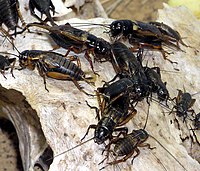
Photo from wikipedia
Simple Summary Asymmetry in bilateral structures occurs when animals experience perturbations during development. This fluctuating asymmetry (FA) may serve as a reliable indicator of the functional importance of a structure.… Click to show full abstract
Simple Summary Asymmetry in bilateral structures occurs when animals experience perturbations during development. This fluctuating asymmetry (FA) may serve as a reliable indicator of the functional importance of a structure. For example, locomotor structures often display lower levels of FA than other paired structures, highlighting that selection can maintain symmetry in traits important for survival or reproduction. Species that have multiple distinct morphs with unique behaviors and morphologies represent an attractive model for studying the relationship between symmetry and function. The sand field cricket (Gryllus firmus) has two separate morphs that allow us to directly test whether individuals maintain higher levels of symmetry in the structures most vital for maximizing fitness based on their specific life strategy. Longwing (LW) individuals can fly but postpone reproduction until after a dispersal event, whereas shortwing (SW) individuals cannot fly but begin reproducing in early adulthood. We quantified FA across a suite of key morphological structures indicative of investment in growth, reproduction, and flight capability for males and females across the morphs. Although we did not find significant differences in FA across traits, as predicted, locomotor compensation strategies may reduce selective pressures on symmetry or developmental patterns may limit the optimization between trait form and function. Abstract Fluctuating asymmetry (FA) may serve as a reliable indicator of the functional importance of structures within an organism. Primary locomotor structures often display lower levels of FA than other paired structures, highlighting that selection can maintain symmetry in fitness-enhancing traits. Polyphenic species represent an attractive model for studying the fine-scale relationship between trait form and function, because multiple morphs exhibit unique life history adaptations that rely on different traits to maximize fitness. Here, we investigated whether individuals of the wing polyphenic sand field cricket (Gryllus firmus) maintain higher levels of symmetry in the bilateral structures most vital for maximizing fitness based on their specific life history strategy. We quantified FA and directional asymmetry (DA) across a suite of key morphological structures indicative of investment in somatic growth, reproduction, and flight capability for males and females across the flight-capable longwing (LW) and flight-incapable shortwing (SW) morphs. Although we did not find significant differences in FA across traits, hindwings lacked DA that was found in all other structures. We predicted that functionally important traits should maintain a higher level of symmetry; however, locomotor compensation strategies may reduce the selective pressures on symmetry or developmental constraints may limit the optimization between trait form and function.
Journal Title: Insects
Year Published: 2022
Link to full text (if available)
Share on Social Media: Sign Up to like & get
recommendations!